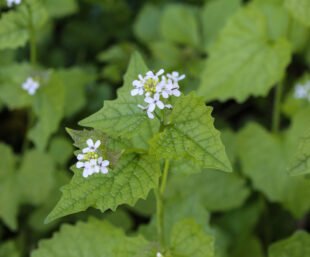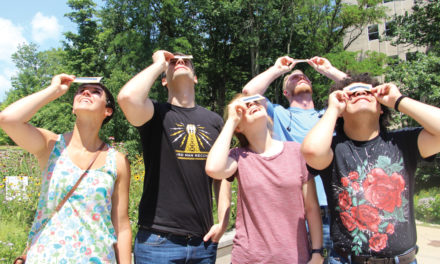
Garlic mustard isn’t the only botanical troublemaker thriving in our fields and forests, but it’s among the most insidious. Deceptively small at first, the biennial jumps from about 4 inches tall during its initial year to as much as 4 feet tall during year two. About now, second-year plants—covered with clusters of white, four-petaled flowers—are setting seed prolifically, and that’s not good.
An invasive species, garlic mustard displaces native grasses, spring-flowering plants, and young trees like oak, maple, and cherry. This, in turn, disrupts the forest understory and impacts the insects and animals that depend on native flora for shelter and food.

Unfortunately, a thick stand of garlic mustard can release roughly 100,000 seeds over a 10-square-foot area, and each seed can remain viable for several years. The plants themselves release growth-suppressing chemicals into the soil, further hampering competing native species.
The good news? The invasive weed is easy to identify. Settlers originally brought garlic mustard to North America for use as an edible and medicinal herb, and you’ve probably already seen (and smelled!) it yourself. Crushing the plants’ leaves releases its unmistakable, garlicky scent.
The plant is so widespread that it’s become a focal species for thousands of citizen scientists. For instance, since its 2008 inception, the Global Garlic Mustard Field Survey has amassed sighting data from citizen scientists and academicians in 16 countries in North America and Europe.
And, closer to home, citizen scientists in Indiana are submitting statewide distribution reports for garlic mustard—and other invasive plant species—via ReportIN. Reports can be entered online or via the Great Lakes Early Detection Network app which is available for Android and iOS devices.
Locals also have access to Monroe County–Identify and Reduce Invasive Species (MC-IRIS). The group of area invasive plant experts meets regularly and, if you live in Monroe County, they’ll even visit your land to complete an invasive plant survey for you.
Want to get your hands dirty? Hand-pulling garlic mustard before it flowers is one effective means of control. FARMbloomington owner and chef Daniel Orr eats the garlic mustard he pulls. “The leaves and flowers taste like a combination of garlic and broccoli rabe,” Orr says. Young leaves work in pesto, salads, and sandwiches. “More mature leaves can be braised or slow-cooked,” Orr adds.
In the spring, look for public garlic mustard-pulling events. And in the meantime? MC-IRIS and the City of Bloomington Parks and Recreation Department are hosting First Saturday Invasive Control Workdays through November. Participants identify different invasive plant species and spend a few hours tackling problem plants in public parks. Call 812-349-3497 to register.





